History
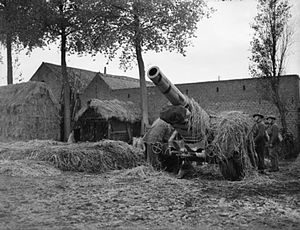 A declaration of war usually means that the people in both areas within the dispute had better prepare for eminent attack, because the declaration of war is like firing the warning shot before the actual open-fire begins. Of course, it may not be an immediate attack, but the attack always comes…or does it. On September 3, 1939, the United Kingdom and France declared war on Nazi Germany, after the Germans invaded Poland. Over the next eight months, at the start of World War II, there were no major military land operations on the Western Front. Strange, considering that the United Kingdom and France had declared war on Nazi Germany. You would think that they would attack or something, but nothing happened. During those eight months, Poland was overrun. It took about five weeks for the German Invasion of Poland beginning September 1, 1939 and the Soviet invasion beginning on 17 September 1939. Still, the Western Allies did nothing. I guess I don’t understand that. War had been declared by each side, but no Western power would
A declaration of war usually means that the people in both areas within the dispute had better prepare for eminent attack, because the declaration of war is like firing the warning shot before the actual open-fire begins. Of course, it may not be an immediate attack, but the attack always comes…or does it. On September 3, 1939, the United Kingdom and France declared war on Nazi Germany, after the Germans invaded Poland. Over the next eight months, at the start of World War II, there were no major military land operations on the Western Front. Strange, considering that the United Kingdom and France had declared war on Nazi Germany. You would think that they would attack or something, but nothing happened. During those eight months, Poland was overrun. It took about five weeks for the German Invasion of Poland beginning September 1, 1939 and the Soviet invasion beginning on 17 September 1939. Still, the Western Allies did nothing. I guess I don’t understand that. War had been declared by each side, but no Western power would 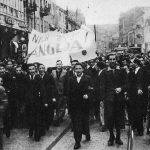 launch a significant land offensive…even though the terms of the Anglo-Polish and Franco-Polish military alliances obligated the United Kingdom and France to assist Poland. They simply stood by and let it happen.
launch a significant land offensive…even though the terms of the Anglo-Polish and Franco-Polish military alliances obligated the United Kingdom and France to assist Poland. They simply stood by and let it happen.
The quiet of the so-named Phoney War was marked by a few Allied actions. During the Saar Offensive in September, France attacked Germany with the intention of assisting Poland, but the attack fizzled out within days and the French withdrew. In November, the Soviets attacked Finland in the Winter War. This resulted in much debate in France and Britain about helping Finland, but this campaign was delayed until the Winter War ended in March. The Allied discussions about a Scandinavian campaign caused concern in Germany and resulted in the German invasion of Denmark and Norway in April. Then the Allied troops that were previously assembled for Finland were redirected to Norway instead. Fighting there continued until June when the Allies evacuated, ceding Norway to Germany in response to the German invasion of France, which had taken place on May 10, 1940.
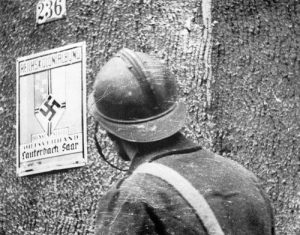
The Germans launched attacks at sea during the autumn and winter of 1939, against British aircraft carriers and destroyers, sinking several including the carrier HMS Courageous with the loss of 519 lives. Action in the air began on October 16, 1939 when the Luftwaffe launched air raids on British warships. There were various minor bombing raids and reconnaissance flights on both sides, but nothing that could possibly be viewed as a clear offensive….and during that whole time, people were dying and being subjected to various atrocities, because no one would help. Yes, war was declared, but it was a phony war, and apparently a phony declaration.

 May 30, 2002 dawned, a typically warm New York City day, but this was not a typical day at all. It had been a long, emotionally grueling 8 months and 19 days of cleanup after the September 11, 2001 attacks on the World Trade Center, the Pentagon, and the crash site in Shanksville, Pennsylvania. The majority of the lost were in the World Trade Center in New York City. Those 8 months and 19 days were filled with every possible emotion there could be…from joy when one was found alive, to grief over the lost, to anger at the attack, to hate for the Muslim attackers, to love for the survivors and the families of the lost. It was something that we all knew that we could never really wrap our heads around, and something that we knew we would never forget. It was a senseless attack that proved only that the attackers were insane and filled with hate for Americans and Christians. It was a time when America came together as one, and donated time, money, letters, and love to each other, because we were all victims of this attack, after all.
May 30, 2002 dawned, a typically warm New York City day, but this was not a typical day at all. It had been a long, emotionally grueling 8 months and 19 days of cleanup after the September 11, 2001 attacks on the World Trade Center, the Pentagon, and the crash site in Shanksville, Pennsylvania. The majority of the lost were in the World Trade Center in New York City. Those 8 months and 19 days were filled with every possible emotion there could be…from joy when one was found alive, to grief over the lost, to anger at the attack, to hate for the Muslim attackers, to love for the survivors and the families of the lost. It was something that we all knew that we could never really wrap our heads around, and something that we knew we would never forget. It was a senseless attack that proved only that the attackers were insane and filled with hate for Americans and Christians. It was a time when America came together as one, and donated time, money, letters, and love to each other, because we were all victims of this attack, after all.
On May 29, 2002, the last beam was removed from the site…marking the end of the cleanup effort that had been expected to last a year. There were many disappointments in the cleanup, because there were very few people pulled out alive after that first day, and in fact, the last survivor was pulled out 27 hours after the attack. There would be no more lives saved. People were lined up to donate blood in the hope that someone’s life could be saved, but the sad reality was that very few whole bodies were even pulled from the rubble. Most were bits and pieces, body parts, and even just fragments of bone or teeth. Authorities put the final death toll from the World Trade Center’s destruction at 2,823. Of those 2823 people, only 1,102 victims have been identified, and only 289 intact bodies were recovered.
The ceremony…if it could really be called that, because ceremony usually means a happy event…began in silence. There would be no speeches. Thousands of people stood silently in one place…Ground Zero, and no one spoke…no one spoke!! The ceremony began with the sound of a fire bell ringing for the fallen firefighters at 10:29 am ET, the same time the World Trade Center’s north tower collapsed on September 11, 2001. Thousands of people stood in silence, some with tears streaming from their eyes, as an honor guard made up of police, firefighters, and representatives of other agencies walked slowly up a ramp from the site carrying a stretcher bearing only an American flag. The flag, symbolizing the victims who were killed on September 11, but never found, was placed into a waiting ambulance. It was followed by a flatbed truck carrying the last 50 ton steel column from the site of the Trade Center ruins. The beam was part of the southeast corner of the south tower. It was hoisted onto a flatbed truck and shrouded in black cloth after its removal on May 29, 2002. Ten minutes into the ceremony, a pair of buglers…one from New York’s Police Department, the other from the New York Fire Department…played “Taps,” followed by a flyover of NYPD helicopters. Among the dead following the horrific attack, were 343 New York firefighters and an estimated 70 police officers from various departments, including 37 from New York’s Port Authority and 23 from the New York Police Department. Fewer than half of the firefighters who died were recovered. Five of them were from the Chelsea Firehouse, Engine 3 and Ladder 12. At the fire stations and police stations in New York City, dozens of family and friends watched the tribute on television. Hundreds of workers had labored around the clock since September 11 to recover the 
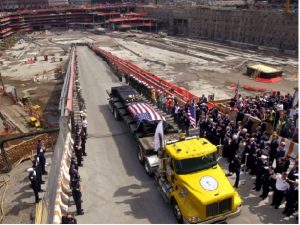 bodies of those who died in the attack and to remove the 1.6 million tons of steel and concrete left behind. The debris was moved to a Staten Island landfill, but reminders of the attack remain in the area. “It’s over, but it will never be forgotten,” said FDNY Battalion Commander Richard Picciotto, who was in the north tower when it was hit. He was right. Today marks the 15th anniversary of that ceremony, and we have not forgotten.
bodies of those who died in the attack and to remove the 1.6 million tons of steel and concrete left behind. The debris was moved to a Staten Island landfill, but reminders of the attack remain in the area. “It’s over, but it will never be forgotten,” said FDNY Battalion Commander Richard Picciotto, who was in the north tower when it was hit. He was right. Today marks the 15th anniversary of that ceremony, and we have not forgotten.
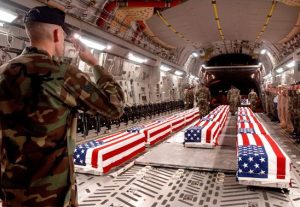 Memorial Day…the day we set aside to remember the heroes of our wars, who paid the ultimate price for the freedoms we hold dear. The men and women who were killed in the attack on Pearl Harbor come to mind, as do those lost on the beaches of Normandy, but there are so many others. From the fliers, to the foot soldiers, to the sailors…men and women, from the Revolutionary War, to the War on Terror, have set aside their goals in life, left their families at home, pushed back their fears, and done their duty to serve their country, and for so many of them, it was a one way ticket over there. They fought and died so that someone they didn’t know could be free and have the rights that so many take for granted. They looked away when they were protested, but deep down they wondered why people didn’t understand. They tried not to watch the news of death and destruction. They just did their job, until they lost their lives in a war they wished had never started.
Memorial Day…the day we set aside to remember the heroes of our wars, who paid the ultimate price for the freedoms we hold dear. The men and women who were killed in the attack on Pearl Harbor come to mind, as do those lost on the beaches of Normandy, but there are so many others. From the fliers, to the foot soldiers, to the sailors…men and women, from the Revolutionary War, to the War on Terror, have set aside their goals in life, left their families at home, pushed back their fears, and done their duty to serve their country, and for so many of them, it was a one way ticket over there. They fought and died so that someone they didn’t know could be free and have the rights that so many take for granted. They looked away when they were protested, but deep down they wondered why people didn’t understand. They tried not to watch the news of death and destruction. They just did their job, until they lost their lives in a war they wished had never started.
 Most of us knew very few soldiers who lost their lives in defense of their country, and some of us may not have known any at all, even though some of our ancestors might have been casualties of a war. I think that sometimes the families of the lost feel alone in their grief. Unless someone has been in that position, they have a difficult time really understanding the depth of the loss. People try to be understanding, imagining how they would feel if it was them, but the reality is that our imaginations are not that good. Those who have lost a loved one to war can never forget the loss or the grief they feel. Grief has no timetable, and some pain just never goes away. No pain is more horrible than losing your child, and losing them in war, seriously compounds that pain.
Most of us knew very few soldiers who lost their lives in defense of their country, and some of us may not have known any at all, even though some of our ancestors might have been casualties of a war. I think that sometimes the families of the lost feel alone in their grief. Unless someone has been in that position, they have a difficult time really understanding the depth of the loss. People try to be understanding, imagining how they would feel if it was them, but the reality is that our imaginations are not that good. Those who have lost a loved one to war can never forget the loss or the grief they feel. Grief has no timetable, and some pain just never goes away. No pain is more horrible than losing your child, and losing them in war, seriously compounds that pain.
Memorial Day, or Decoration Day as it was first called, started three years after the Civil War ended, on May 5,  1868. It was established by the head of an organization of Union veterans…the Grand Army of the Republic. Decoration Day was a time for the nation to decorate the graves of the war dead with flowers. Major General John A Logan declared that Decoration Day should be observed on May 30. It is believed that date was chosen because flowers would be in bloom all over the country. The first large observance was held that year at Arlington National Cemetery, across the Potomac River from Washington, DC. It was a day for all citizens to remember the sacrifice of the brave fallen heroes. And to let the families know that their fallen soldier would ever be forgotten. In honor of all the fallen, may you rest in peace. Thank you for your great sacrifice. Your nation is grateful.
1868. It was established by the head of an organization of Union veterans…the Grand Army of the Republic. Decoration Day was a time for the nation to decorate the graves of the war dead with flowers. Major General John A Logan declared that Decoration Day should be observed on May 30. It is believed that date was chosen because flowers would be in bloom all over the country. The first large observance was held that year at Arlington National Cemetery, across the Potomac River from Washington, DC. It was a day for all citizens to remember the sacrifice of the brave fallen heroes. And to let the families know that their fallen soldier would ever be forgotten. In honor of all the fallen, may you rest in peace. Thank you for your great sacrifice. Your nation is grateful.
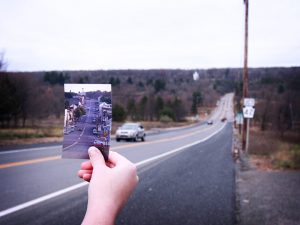
 Sometimes, the best of intentions can go horribly wrong, and when things go wrong, it becomes a disaster, and disaster is exactly what happened in Centralia, Pennsylvania when a fire was set to burn out an old landfill before the Labor Day holiday in 1962. The fire that was started on May 27, 1962, seemed like a simple solution to a big mess, but the landfill was also an old strip-mine pit, connected to a maze of abandoned underground mining tunnels full of coal. No one knows how the fire got to the coal vein below the ground, but once it did, the situation was out of control. Some called it careless trash incineration in a landfill next to an open pit mine, which ignited a coal vein, but no one expected the fire to crawl insidiously along the rich coal deposits that still laid deep in the ground. No one expected the burning coal to vent hot and poisonous gases up into town, through the basements of homes and businesses. Nevertheless, with dawn came the horror, as residents realized that the fire was not going to be extinguished, or in fact, ever burn itself out…at least not until all the interconnected coal veins in eastern Pennsylvania were finally burned out. As the underground fire worked its way under rows of homes and businesses, the threat of fires, asphyxiation, and carbon monoxide poisoning became a daily concern.
Sometimes, the best of intentions can go horribly wrong, and when things go wrong, it becomes a disaster, and disaster is exactly what happened in Centralia, Pennsylvania when a fire was set to burn out an old landfill before the Labor Day holiday in 1962. The fire that was started on May 27, 1962, seemed like a simple solution to a big mess, but the landfill was also an old strip-mine pit, connected to a maze of abandoned underground mining tunnels full of coal. No one knows how the fire got to the coal vein below the ground, but once it did, the situation was out of control. Some called it careless trash incineration in a landfill next to an open pit mine, which ignited a coal vein, but no one expected the fire to crawl insidiously along the rich coal deposits that still laid deep in the ground. No one expected the burning coal to vent hot and poisonous gases up into town, through the basements of homes and businesses. Nevertheless, with dawn came the horror, as residents realized that the fire was not going to be extinguished, or in fact, ever burn itself out…at least not until all the interconnected coal veins in eastern Pennsylvania were finally burned out. As the underground fire worked its way under rows of homes and businesses, the threat of fires, asphyxiation, and carbon monoxide poisoning became a daily concern.
Probably one of the scariest situations was when a young man, Todd Domboski fell into a hot, steaming hole created by mine fire subsidence. He survived his 45 second ordeal by grabbing onto tree roots, and screaming for help until his cousin ran to his aid, reached into the void, and hoisted him out. Many Centralia residents had worried that a calamity like the one that nearly unfolded that Valentine’s Day in 1981. Four years earlier, Domboski’s father had told a reporter, “I guess some kid will have to get killed by the gas or by falling in one of these steamy holes before anyone will call it an emergency.” Never did he imagine that it would be his kid that would fall through and almost lose his life.
After the near tragedy, signs were posted to warn visitors to the Centralia area about the dangers of death by asphyxiation or being swallowed by the ground, but the old mining town of Centralia, Pennsylvania, was once home to more than 1,000 people. People with no place else to go. Now, it’s nothing more than a smoldering ghost town that’s been burning for over half a century. Though the town was able to extinguish the fire above ground, a much bigger inferno burned underneath, and it eventually spread its way under Centralia’s town center. The fire was so widespread, destructive and unending. It’s thought that there’s enough coal underground to fuel the fire for another 250 years. In 1980, a $42 million relocation plan incentivized most of the townspeople to relocate and most of the homes were demolished, leaving only about a dozen holdouts behind. Today, Centralia exists only as an eerie grid of streets, its driveways disappearing into vacant lots. Remains of a picket fence here, a chair spindle there. Still John Lokitis and 11 others who refused to leave, the 
 occupants of a dozen scattered structures. Over the decades, the ground has opened up with sulfurous gases sometimes billowing out. The road along Highway 61 swells and cracks open. It is riddled with graffiti and hot to the touch. In the winter, snow melts in patches where the ground is warm. While a few holdouts still live there, I have to wonder what they are thinking. That is like slowly committing suicide, because you refuse to leave the past.
occupants of a dozen scattered structures. Over the decades, the ground has opened up with sulfurous gases sometimes billowing out. The road along Highway 61 swells and cracks open. It is riddled with graffiti and hot to the touch. In the winter, snow melts in patches where the ground is warm. While a few holdouts still live there, I have to wonder what they are thinking. That is like slowly committing suicide, because you refuse to leave the past.
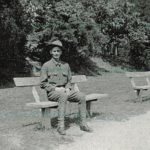
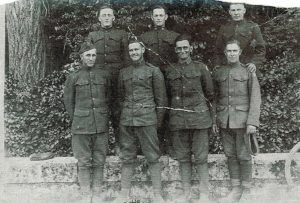 When the United States entered World War I, they sent men into France to join Allied forces there. Their arrival was a great relief to the exhausted Allied soldiers. Before long the American soldiers in France became known as Doughboys. This was not an unknown term, since it had been used For centuries to describe such soldiers as Horatio Nelson’s sailors and Wellington’s soldiers in Spain, for instance. Both of these groups were familiar with fried flour dumplings called doughboys, the predecessor of the modern doughnut that both we and the Doughboys of World War I came to love. The American Doughboys were the men America sent to France in the Great War, who beat Kaiser Bill and fought to make the world safe for Democracy.
When the United States entered World War I, they sent men into France to join Allied forces there. Their arrival was a great relief to the exhausted Allied soldiers. Before long the American soldiers in France became known as Doughboys. This was not an unknown term, since it had been used For centuries to describe such soldiers as Horatio Nelson’s sailors and Wellington’s soldiers in Spain, for instance. Both of these groups were familiar with fried flour dumplings called doughboys, the predecessor of the modern doughnut that both we and the Doughboys of World War I came to love. The American Doughboys were the men America sent to France in the Great War, who beat Kaiser Bill and fought to make the world safe for Democracy.
It is thought, however, that the Doughboys of World War I might have acquired the name in a slightly different way. In fact, there are a variety of theories about the origins of the nickname. One explanation is that the term dates back to the Mexican War of 1846 to 1848, when American infantrymen made long treks over dusty terrain, giving them the appearance of being covered in flour, or dough. As a variation of this account goes, the men were coated in the dust of adobe soil and as a result were called “adobes,” which morphed into “dobies” and, eventually into “doughboys.” Among other theories, according to “War Slang” by Paul Dickson, American journalist and lexicographer H.L. Mencken claimed the nickname could be traced to Continental Army soldiers who kept the piping on their uniforms white through the application of clay. When the troops got rained on the clay on their uniforms turned into “doughy blobs,” supposedly leading to the doughboy moniker.
Whatever the case may be, doughboy was just one of the nicknames given to those who fought in the Great War. For example, “poilu” meaning “hairy one” was a term for a French soldier, as a number of them had beards or mustaches, while a popular slang term for a British soldier was “Tommy,” an abbreviation of Tommy Atkins, a generic name similar to John Doe used in the Unites States on government forms. America’s last 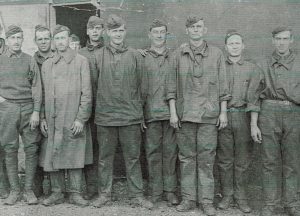
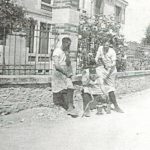 World War I doughboy, Frank Buckles, died in 2011 in West Virginia at age 110. Buckles enlisted in the Army at age 16 in August 1917, four months after the United States entered the conflict, and drove military vehicles in France. One of 4.7 million Americans who served in the war, Buckles was buried at Arlington National Cemetery. It’s strange to think that my grandfather, George Byer was one of the men called doughboys, but then he was stationed in France at that time in history, so I guess that Grandpa was a doughboy.
World War I doughboy, Frank Buckles, died in 2011 in West Virginia at age 110. Buckles enlisted in the Army at age 16 in August 1917, four months after the United States entered the conflict, and drove military vehicles in France. One of 4.7 million Americans who served in the war, Buckles was buried at Arlington National Cemetery. It’s strange to think that my grandfather, George Byer was one of the men called doughboys, but then he was stationed in France at that time in history, so I guess that Grandpa was a doughboy.

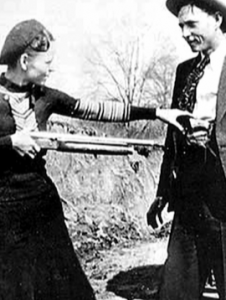 Most of the time, when we think of crime and criminals, we think of the worst evil there could be in a person, and I suppose that some criminals have more evil tendencies than others, but once in a while, someone decides to put a bit of a different twist on their crime…intending to romanticize it or give it a Robin Hood feel. In a large part, it is the media that truly romanticizes it or gives it notoriety. If the media didn’t report on every episode of the criminal’s life of crime, perhaps it would not seem so exciting to people, and maybe it wouldn’t inspire other criminals to…go for it. It all seems so exciting, at least that’s how the media plays it up.
Most of the time, when we think of crime and criminals, we think of the worst evil there could be in a person, and I suppose that some criminals have more evil tendencies than others, but once in a while, someone decides to put a bit of a different twist on their crime…intending to romanticize it or give it a Robin Hood feel. In a large part, it is the media that truly romanticizes it or gives it notoriety. If the media didn’t report on every episode of the criminal’s life of crime, perhaps it would not seem so exciting to people, and maybe it wouldn’t inspire other criminals to…go for it. It all seems so exciting, at least that’s how the media plays it up.
In reality, Bonnie and Clyde…notorious robbers and murders lived a very basic existence, and in many ways it was disgusting. Despite common popular culture depictions of Bonnie and Clyde, their life on the run was far from glamorous. They often ate sardines from the can, bathed in rivers, and drove through the night, taking shifts sleeping and driving, all in order to evade capture. They hid out in the forest, hoping not to be seen…always standing guard…always watching. Bonnie Parker met Clyde Barrow in Texas when she was 19 years old. Her husband, whom she married when she was 16, was serving time in jail for murder, and Clyde seemed exciting. Shortly after they met, Barrow was imprisoned for robbery. Bonnie visited Clyde every day, and smuggled a gun into prison to help him escape. He did escape, but was quickly recaptured in Ohio and sent back to jail. When Clyde was paroled in 1932, he immediately hooked up with Bonnie, and the couple began a life of crime together. Apparently Bonnie had a thing for bad boys…to her detriment, in the end.
The pair stole a car and committed several robberies, before Bonnie was caught by police and sent to jail for  two months. Immediately after her release in mid-1932, she hooked up with Clyde again. Over the next two years, the couple teamed with various accomplices to rob a string of banks and stores across five states…Texas, Oklahoma, Missouri, New Mexico and Louisiana. To law enforcement agents, the Barrow Gang, including Clyde’s childhood friend, Raymond Hamilton, W.D. Jones, Henry Methvin, Barrow’s brother Buck and his wife Blanche, among others, were cold-blooded criminals who didn’t hesitate to kill anyone who got in their way, especially police or sheriff’s deputies. To the public, however, Bonnie and Clyde’s reputation as dangerous outlaws was mixed with a romantic view of the couple as “Robin Hood”-like folk heroes. Their fame was increased by the fact that Bonnie was a woman, which made her an unlikely criminal, and by the fact that the couple posed for playful photographs together, which were later found by police and released to the media. Police almost captured Bonnie and Clyde in the spring of 1933, with surprise raids on their hideouts in Joplin and Platte City, Missouri. Buck Barrow was killed in the second raid, and Blanche was arrested, but Bonnie and Clyde escaped once again. In January 1934, they attacked the Eastham Prison Farm in Texas to help Hamilton break out of jail, shooting several guards with machine guns…killing one.
two months. Immediately after her release in mid-1932, she hooked up with Clyde again. Over the next two years, the couple teamed with various accomplices to rob a string of banks and stores across five states…Texas, Oklahoma, Missouri, New Mexico and Louisiana. To law enforcement agents, the Barrow Gang, including Clyde’s childhood friend, Raymond Hamilton, W.D. Jones, Henry Methvin, Barrow’s brother Buck and his wife Blanche, among others, were cold-blooded criminals who didn’t hesitate to kill anyone who got in their way, especially police or sheriff’s deputies. To the public, however, Bonnie and Clyde’s reputation as dangerous outlaws was mixed with a romantic view of the couple as “Robin Hood”-like folk heroes. Their fame was increased by the fact that Bonnie was a woman, which made her an unlikely criminal, and by the fact that the couple posed for playful photographs together, which were later found by police and released to the media. Police almost captured Bonnie and Clyde in the spring of 1933, with surprise raids on their hideouts in Joplin and Platte City, Missouri. Buck Barrow was killed in the second raid, and Blanche was arrested, but Bonnie and Clyde escaped once again. In January 1934, they attacked the Eastham Prison Farm in Texas to help Hamilton break out of jail, shooting several guards with machine guns…killing one.
Texan prison officials hired Captain Frank Hamer, a retired Texas police officer, as a special investigator to track down Bonnie and Clyde. After a three month search, Hamer traced the couple to Louisiana, where Henry Methvin’s family lived. Bonnie and Clyde appeared, the officers opened fire, killing the couple instantly in a hail of 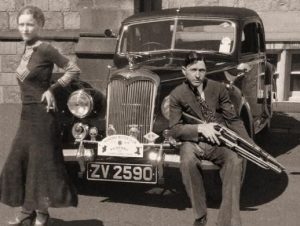
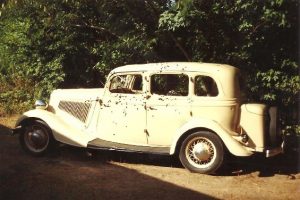 bullets. All told, the Barrow Gang was believed to have been responsible for the deaths of 13 people, including nine police officers. Bonnie and Clyde are still seen by many as romantic figures, however, especially after the success of the 1967 film Bonnie and Clyde, starring Faye Dunaway and Warren Beatty. It’s really a sad thing when crime is romanticized, because people think of it as an exciting, when in fact, it is a dead end road.
bullets. All told, the Barrow Gang was believed to have been responsible for the deaths of 13 people, including nine police officers. Bonnie and Clyde are still seen by many as romantic figures, however, especially after the success of the 1967 film Bonnie and Clyde, starring Faye Dunaway and Warren Beatty. It’s really a sad thing when crime is romanticized, because people think of it as an exciting, when in fact, it is a dead end road.
 As airplanes became an accepted form of transportation, people began to consider traveling further and further. Of course, those first airplanes could never have made the flight across the ocean, but these days planes fly that far with ease. Still, someone had to be brave enough to take that first flight across the ocean. Someone had to trust their plane enough to make the attempt. British aviators John Alcock and Arthur Brown decided to be the first to make that leap when they made the first non-stop transatlantic flight in June 1919. Their plane was a modified First World War Vickers Vimy bomber. They flew from Saint John’s, Newfoundland to Clifden, Connemara, County Galway, Ireland. Like most accomplishments, the competition was fierce, and there had to be a reward for the winner. The Secretary of State for Air, Winston Churchill, presented them with the Daily Mail prize for the first crossing of the Atlantic Ocean by airplane in “less than 72 consecutive hours”. A small amount of mail was carried on the flight, making it the first transatlantic airmail flight. The two aviators were awarded the honour of Knight Commander of the Most Excellent Order of the British Empire a week later by King George V at Windsor Castle.
As airplanes became an accepted form of transportation, people began to consider traveling further and further. Of course, those first airplanes could never have made the flight across the ocean, but these days planes fly that far with ease. Still, someone had to be brave enough to take that first flight across the ocean. Someone had to trust their plane enough to make the attempt. British aviators John Alcock and Arthur Brown decided to be the first to make that leap when they made the first non-stop transatlantic flight in June 1919. Their plane was a modified First World War Vickers Vimy bomber. They flew from Saint John’s, Newfoundland to Clifden, Connemara, County Galway, Ireland. Like most accomplishments, the competition was fierce, and there had to be a reward for the winner. The Secretary of State for Air, Winston Churchill, presented them with the Daily Mail prize for the first crossing of the Atlantic Ocean by airplane in “less than 72 consecutive hours”. A small amount of mail was carried on the flight, making it the first transatlantic airmail flight. The two aviators were awarded the honour of Knight Commander of the Most Excellent Order of the British Empire a week later by King George V at Windsor Castle.
As with any record, there is always room for improvement. The first flight took place with two people on board, so on Ma 21, 1927, at age 25, Charles Lindbergh went from being an unknown United States Air Mail pilot, to world fame instantly, by making his Orteig Prize winning nonstop flight from Long Island, New York to Paris. He covered the 33½ hour, 3,600 miles alone in a single-engine Ryan monoplane called the Spirit of Saint Louis. 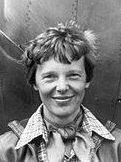 The plane was build for this flight. This was the first solo transatlantic flight, and the first non-stop flight between North America and mainland Europe. I wonder what he was thinking as he flew for 33½ hours alone over the ocean. He had to keep himself awake, and on course. There was no one else to do it. Most of us have a hard time staying awake for more than 17 or 18 hours, much less 33½ hours. It was an amazing feat, and one for which the fame he gained was well deserved.
The plane was build for this flight. This was the first solo transatlantic flight, and the first non-stop flight between North America and mainland Europe. I wonder what he was thinking as he flew for 33½ hours alone over the ocean. He had to keep himself awake, and on course. There was no one else to do it. Most of us have a hard time staying awake for more than 17 or 18 hours, much less 33½ hours. It was an amazing feat, and one for which the fame he gained was well deserved.
As with any record, someone had to beat it or improve on it or change it in some way. The record held until May 21, 1932, when Amelia Earhart became the first woman to make a solo air crossing of the Atlantic Ocean, from Newfoundland to Ireland. As with Charles Lindbergh, I wondered how Amelia stayed awake for all those hours, and what she was thinking as she flew along…alone for all those hours. I’m sure there was excitement in the extreme, but I’m sure she was weary after the flight was over too.
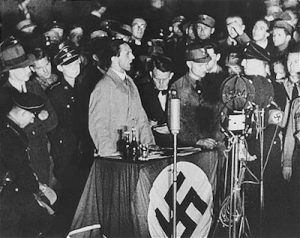 One of the best ways to form a dictatorship is to suppress knowledge. That’s one reason that propaganda is so important. When the people only hear what the government wants them to, they tend to become compliant…or at least that’s the theory. When Adolf Hitler was elected to office, he was the people’s choice, but they had no idea just how evil he was and how long they would be stuck with him. With the end of democracy, Germany became a one-party dictatorship. The Nazis began a massive propaganda campaign to win the loyalty and cooperation of Germans. The Nazi Propaganda Ministry, directed by Dr Joseph Goebbels, took control of all forms of communication in Germany…newspapers, magazines, books, public meetings, and rallies, art, music, movies, and radio. Viewpoints in any way threatening to Nazi beliefs or to the regime were censored or eliminated from all media. The German people were isolated from the outside world, and while they did not like it, the government became their only source of information.
One of the best ways to form a dictatorship is to suppress knowledge. That’s one reason that propaganda is so important. When the people only hear what the government wants them to, they tend to become compliant…or at least that’s the theory. When Adolf Hitler was elected to office, he was the people’s choice, but they had no idea just how evil he was and how long they would be stuck with him. With the end of democracy, Germany became a one-party dictatorship. The Nazis began a massive propaganda campaign to win the loyalty and cooperation of Germans. The Nazi Propaganda Ministry, directed by Dr Joseph Goebbels, took control of all forms of communication in Germany…newspapers, magazines, books, public meetings, and rallies, art, music, movies, and radio. Viewpoints in any way threatening to Nazi beliefs or to the regime were censored or eliminated from all media. The German people were isolated from the outside world, and while they did not like it, the government became their only source of information.
Germany was now led by a self-educated, high school drop-out named Adolf Hitler, who was by nature strongly anti-intellectual. For Hitler, the reawakening of the long-dormant Germanic spirit, with its racial and militaristic 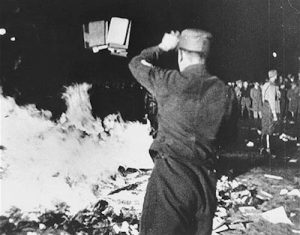 qualities, was far more important than any traditional notions of learning. Books and writings by such authors as Henri Barbusse, Franz Boas, John Dos Passos, Albert Einstein, Lion Feuchtwanger, Friedrich Förster, Sigmund Freud, John Galsworthy, André Gide, Ernst Glaeser, Maxim Gorki, Werner Hegemann, Ernest Hemingway, Erich Kästner, Helen Keller, Alfred Kerr, Jack London, Emil Ludwig, Heinrich Mann, Thomas Mann, Karl Marx, Hugo Preuss, Marcel Proust, Erich Maria Remarque, Walther Rathenau, Margaret Sanger, Arthur Schnitzler, Upton Sinclair, Kurt Tucholsky, Jakob Wassermann, H.G. Wells, Theodor Wolff, Emilé Zola, Arnold Zweig, and Stefan Zweig, were suddenly unGerman. Their books were pulled from libraries and schools. Then, on the night of May 10, 1933, an event unseen in Europe since the Middle Ages occurred as German students from universities once regarded as among the finest in the world, gathered in Berlin to burn books with unGerman ideas. It was the Nazi burning of knowledge. Students can be very impressionable, and easily lead, and these students played right into Hitler’s hand.
qualities, was far more important than any traditional notions of learning. Books and writings by such authors as Henri Barbusse, Franz Boas, John Dos Passos, Albert Einstein, Lion Feuchtwanger, Friedrich Förster, Sigmund Freud, John Galsworthy, André Gide, Ernst Glaeser, Maxim Gorki, Werner Hegemann, Ernest Hemingway, Erich Kästner, Helen Keller, Alfred Kerr, Jack London, Emil Ludwig, Heinrich Mann, Thomas Mann, Karl Marx, Hugo Preuss, Marcel Proust, Erich Maria Remarque, Walther Rathenau, Margaret Sanger, Arthur Schnitzler, Upton Sinclair, Kurt Tucholsky, Jakob Wassermann, H.G. Wells, Theodor Wolff, Emilé Zola, Arnold Zweig, and Stefan Zweig, were suddenly unGerman. Their books were pulled from libraries and schools. Then, on the night of May 10, 1933, an event unseen in Europe since the Middle Ages occurred as German students from universities once regarded as among the finest in the world, gathered in Berlin to burn books with unGerman ideas. It was the Nazi burning of knowledge. Students can be very impressionable, and easily lead, and these students played right into Hitler’s hand.
The youth-oriented Nazi movement had always attracted a sizable following among university students. Even back in the 1920s they thought Nazism was the wave of the future. They joined the National Socialist 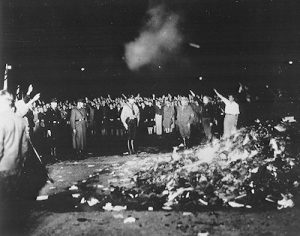 German Students’ League, put on swastika armbands and harassed anti-Nazi teachers. Many formerly reluctant professors were swept along by the outpouring of student enthusiasm that followed Hitler’s seizure of power. Most of the professors eagerly surrendered their intellectual honesty and took the required Nazi oath of allegiance. They also wanted to curry favor with Nazi Party officials in order to grab one of the academic vacancies resulting from the mass expulsion of Jewish professors and deans. The entire education system of a nation changed…almost overnight. As the German-Jewish poet, Heinrich Heine, had declared, a hundred years before the advent of Hitler, “Wherever books are burned, human beings are destined to be burned too.” And so it was in the end.
German Students’ League, put on swastika armbands and harassed anti-Nazi teachers. Many formerly reluctant professors were swept along by the outpouring of student enthusiasm that followed Hitler’s seizure of power. Most of the professors eagerly surrendered their intellectual honesty and took the required Nazi oath of allegiance. They also wanted to curry favor with Nazi Party officials in order to grab one of the academic vacancies resulting from the mass expulsion of Jewish professors and deans. The entire education system of a nation changed…almost overnight. As the German-Jewish poet, Heinrich Heine, had declared, a hundred years before the advent of Hitler, “Wherever books are burned, human beings are destined to be burned too.” And so it was in the end.
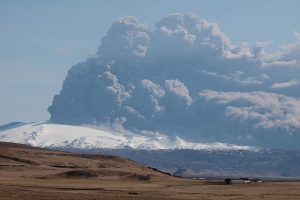 When a volcano erupts, we think of lava and billowing clouds of ash. Those things do happen, but what we don’t think about is what can happen to planes, because of the ash. I suppose that is because we think of that eruption as being a very localized thing. In reality, it isn’t, because the jet stream moves the air around our world, and the ash goes with it. Volcanic ash and airplane engines are not a good mix. Volcanic ash consists of small tephra, which are bits of pulverized rock and glass less than 2 millimeters in diameter created by volcanic eruptions. As the ash enters the atmosphere, it is carried away from the volcano by winds. The ash with the smallest size can remain in the atmosphere for a considerable period of time. The ash cloud can be dangerous to aviation if it reaches the heights of aircraft flight paths.
When a volcano erupts, we think of lava and billowing clouds of ash. Those things do happen, but what we don’t think about is what can happen to planes, because of the ash. I suppose that is because we think of that eruption as being a very localized thing. In reality, it isn’t, because the jet stream moves the air around our world, and the ash goes with it. Volcanic ash and airplane engines are not a good mix. Volcanic ash consists of small tephra, which are bits of pulverized rock and glass less than 2 millimeters in diameter created by volcanic eruptions. As the ash enters the atmosphere, it is carried away from the volcano by winds. The ash with the smallest size can remain in the atmosphere for a considerable period of time. The ash cloud can be dangerous to aviation if it reaches the heights of aircraft flight paths.
Part of the problem is that pilots can’t see ash clouds at night, and ash particles are too small to return an echo to on-board weather radars on commercial airliners. Even when they are flying in daylight, pilots may interpret a visible ash cloud as a normal cloud of water vapor and not a danger…especially if the ash has travelled far from the eruption site. Volcanic ash has a melting point of approximately 2,010° F, which is below the operating temperature of modern commercial jet engines, about 2,550° F. Volcanic ash can damage gas turbines in a number of ways. These can be categorized into those that pose an immediate hazard to the engines and those that present a maintenance problem. As was the case with KLM Flight 867, bound for Anchorage, Alaska, when all four engines flamed out after the aircraft inadvertently entered a cloud of ash blown from erupting Redoubt Volcano, 150 miles away. The volcano had begun erupting 10 hours earlier on that morning of December 15, 1989. Only after the crippled jet had dropped from an altitude of 27,900 feet to 13,300 feet…a fall of more than 2 miles…was the crew able to restart all engines and land the plane safely at Anchorage. The plane required $80 million in repairs, including the replacement of all four damaged engines.
 The 2010 eruptions of Eyjafjallajökull in Iceland, were relatively small for volcanic eruptions. Nevertheless, they caused enormous disruption to air travel across western and northern Europe over the next six days. Additional localized disruption occurred into May 2010. The eruption was declared officially over in October 2010. About 20 countries closed their airspace to commercial jet traffic and it affected about 10 million travelers. This was the highest level of air travel disruption since World War II. It’s strange for us to think that so much can happen to a jet engine is volcanic ash is introduced into it, but that is definitely the case, and if air planes travel in the area of certain types of volcanic ash, planes can be lost. The only prudent thing to do is stop travel in the area…no matter how inconvenient it is to travelers.
The 2010 eruptions of Eyjafjallajökull in Iceland, were relatively small for volcanic eruptions. Nevertheless, they caused enormous disruption to air travel across western and northern Europe over the next six days. Additional localized disruption occurred into May 2010. The eruption was declared officially over in October 2010. About 20 countries closed their airspace to commercial jet traffic and it affected about 10 million travelers. This was the highest level of air travel disruption since World War II. It’s strange for us to think that so much can happen to a jet engine is volcanic ash is introduced into it, but that is definitely the case, and if air planes travel in the area of certain types of volcanic ash, planes can be lost. The only prudent thing to do is stop travel in the area…no matter how inconvenient it is to travelers.
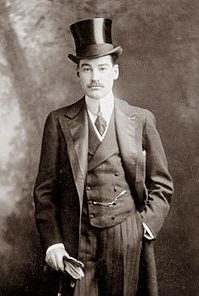 During World War I, the Germans had taken a hard line concerning the waters around England. It was called unrestricted submarine warfare, and it meant that German submarines would attack any ship found in the war zone, which, in this case, was the area around the British Isles…no matter what kind of ship it was, and even if it was from a neutral country. Of course, this was not going to fly, and since Germany was afraid of the United States, they finally agreed to only go after military ships. Nevertheless, mistakes can be made, and that is what happened on May 7, 1915, when a German U-boat torpedoed and sank the RMS Lusitania, a British ocean liner en route from New York to Liverpool, England. Of the more than 1,900 passengers and crew members on board, more than 1,100 perished, including more than 120 Americans. A warning had been placed in several New York newspapers in early May 1915, by the German Embassy in Washington, DC, stating that Americans traveling on British or Allied ships in war zones did so at their own risk. The announcement was placed on the same page as an advertisement of the imminent sailing of the Lusitania liner from New York back to Liverpool. Still this did not stop the sailing of the Lusitania, because the captain of the Lusitania ignored the British Admiralty’s recommendations, and at 2:12 pm on May 7 the 32,000-ton ship was hit by an exploding torpedo on its starboard side. The torpedo blast was followed by a larger explosion, probably of the ship’s boilers, and the ship sank off the south coast of Ireland in less than 20 minutes.
During World War I, the Germans had taken a hard line concerning the waters around England. It was called unrestricted submarine warfare, and it meant that German submarines would attack any ship found in the war zone, which, in this case, was the area around the British Isles…no matter what kind of ship it was, and even if it was from a neutral country. Of course, this was not going to fly, and since Germany was afraid of the United States, they finally agreed to only go after military ships. Nevertheless, mistakes can be made, and that is what happened on May 7, 1915, when a German U-boat torpedoed and sank the RMS Lusitania, a British ocean liner en route from New York to Liverpool, England. Of the more than 1,900 passengers and crew members on board, more than 1,100 perished, including more than 120 Americans. A warning had been placed in several New York newspapers in early May 1915, by the German Embassy in Washington, DC, stating that Americans traveling on British or Allied ships in war zones did so at their own risk. The announcement was placed on the same page as an advertisement of the imminent sailing of the Lusitania liner from New York back to Liverpool. Still this did not stop the sailing of the Lusitania, because the captain of the Lusitania ignored the British Admiralty’s recommendations, and at 2:12 pm on May 7 the 32,000-ton ship was hit by an exploding torpedo on its starboard side. The torpedo blast was followed by a larger explosion, probably of the ship’s boilers, and the ship sank off the south coast of Ireland in less than 20 minutes.
While the sinking of the Lusitania was a horrible tragedy, there were heroics too. One such hero was Alfred Gwynne Vanderbilt, Sr. Vanderbilt was an extremely wealthy American businessman and sportsman, and a member of the famous Vanderbilt family, but on this trip, he was so much more than that. On May 1, 1915, Alfred Vanderbilt boarded the RMS Lusitania bound for Liverpool as a first class passenger. Vanderbilt was on a business trip. He was traveling with only his valet, Ronald Denyer. His family stayed at home in New York. On May 7, off the coast of County Cork, Ireland, German U-boat, U-20 torpedoed the ship, triggering a secondary explosion that sank the giant ocean liner within 18 minutes. Vanderbilt and Denyer immediately went into action, helping others into lifeboats, and then Vanderbilt gave his lifejacket to save a female passenger. Vanderbilt had promised the young mother of a small baby that he would locate an extra life vest for her. Failing to do so, he offered her his own life vest, which he proceeded to tie on to her himself, because she was holding her infant child in her arms at the time.
Vanderbilt had to know he was sealing his own fate, since he could not swim and he knew there were no other life vests or lifeboats available. They were in waters where no outside help was likely to be coming. Still, he 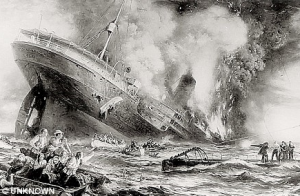 gave his life for hers and that of her child. Because of his fame, several people on the Lusitania who survived the tragedy were observing him while events unfolded at the time, and so they took note of his actions. I suppose that had he not been famous, people would not have known who he was to tell the story. Vanderbilt and Denyer were among the 1198 passengers who did not survive the incident. His body was never recovered. Probably the most ironic fact is that three years earlier Vanderbilt had made a last-minute decision not to return to the US on RMS Titanic. In fact, his decision not to travel was made so late that some newspaper accounts listed him as a casualty after that sinking too. He would not be so fortunate when he chose to travel on Lusitania.
gave his life for hers and that of her child. Because of his fame, several people on the Lusitania who survived the tragedy were observing him while events unfolded at the time, and so they took note of his actions. I suppose that had he not been famous, people would not have known who he was to tell the story. Vanderbilt and Denyer were among the 1198 passengers who did not survive the incident. His body was never recovered. Probably the most ironic fact is that three years earlier Vanderbilt had made a last-minute decision not to return to the US on RMS Titanic. In fact, his decision not to travel was made so late that some newspaper accounts listed him as a casualty after that sinking too. He would not be so fortunate when he chose to travel on Lusitania.

